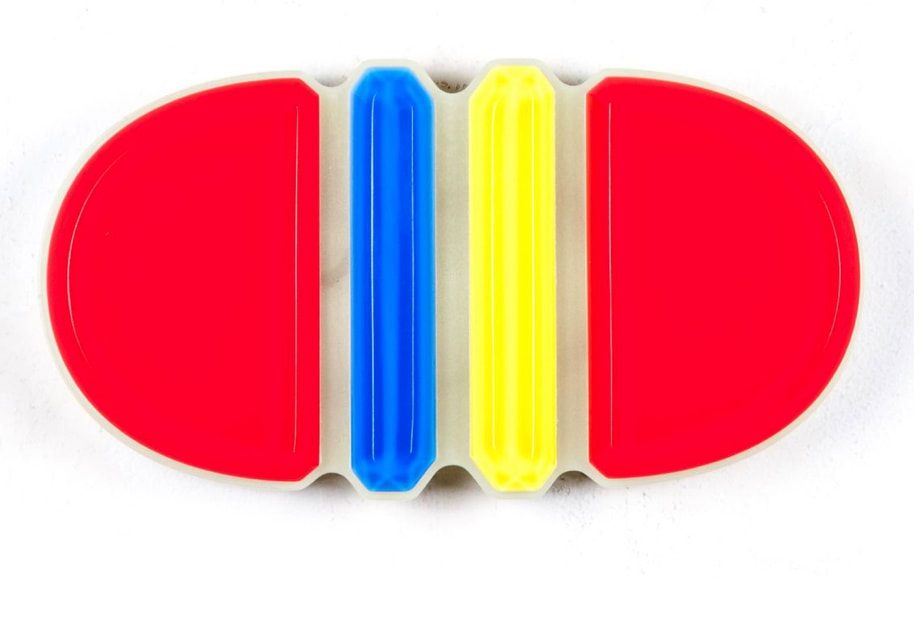
Opening Reception: Saturday, April 13, 4-6 pm at our Elizabeth St. location.
For her second solo exhibition at Kavi Gupta, Beverly Fishman invites viewers to survey the present cultural moment through the lens of three iconic bodies of work: a series of cast resin pharmaceutical pill forms Fishman originated in the late 1990s; a series of phosphorescent pill forms connecting pharmaceutical industry branding to that of ecstasy producers; and a series of enamel paintings on polished stainless steel referencing the visual language of electronic medical imaging.
In context with the contemporary opioid epidemic and Big Pharma’s skyrocketing financial and political influence, these prophetic bodies of work present a starting point from which to examine evolving connections between bio-chemical remedies and those offered by aesthetic perceptual phenomena.
When Fishman began making cast resin pill forms, Big Pharma was still in the early phase of their recent exponential expansion. Fishman was fascinated to see the formal languages of Modernist abstraction being deployed in the laboratories of pharmaceutical giants like Purdue Pharma and Eli Lilly. She subverted the idea, borrowing back the geometric forms and transcendent color relationships that Big Pharma had borrowed from art history. Re-appropriating the pill forms and transforming them into meticulous aesthetic relics, she glorified their haunting chromatic fluctuations as fine art: a testament to a disturbing emergent cultural synthesis of marketing, aesthetics, and chemical engineering.
By adding phosphorescent pigment to her cast resin forms, Fishman began making glow-in-the-dark pills—a poetic visual expression of transcendent elements hidden within, behind the branding.
“What’s inside the work makes it glow,” she says. “It’s a chemical. It also encourages you to engage with the work by turning on and off the lights and by watching the color change.”
The glow-in-the-dark effect calls to mind everything from black lights to glow sticks to neon signage. As the series progressed, Fishman mobilized it not only to explore the true nature of pharmaceuticals, but also to dig deeper into the connections between the branding drug companies use—such as the iconic V on Valium, or the happy moose on the anti-diabetic pill Prandin—and the images embedded on ecstasy pills—such as Bart Simpson, or the profile of President Obama.
“I was joking in this sinister way,” says Fishman. “The shapes are so appealing, you want to eat them. When the Obama ecstasy pill came out, he was the only living person, let alone president, that had ever been put on an ecstasy pill. He was cool. If he wasn’t cool, he wouldn’t have been on a pill. These people want to sell drugs, they don’t care. Obama was put on there because he would sell.”
Fishman’s stainless steel paintings examine a more insidious aspect of our contemporary human relationship with the medical industrial complex—our tacit embrace of our bodies as plastic things subject to analyses and manipulation. Inhabiting an aesthetic position somewhere between Op Art and Pop Art, these paintings flood the senses with illusion and surprise. They celebrate the spectacular abandon with which we allow our bodies to be reduced to delirious series of lines, patterns, and colors then shown back to us on charts and screens. They are not only formal experiments in illusionary aesthetics; they are hyper-stylized representations of how we actually see ourselves.
All three of these fateful bodies of work show how prescient Fishman has always been. The parallels between Big Pharma and the illegal drug industry are publicly apparent today. So is the insight that most pharmaceuticals function as cures as well as poisons depending on how they are taken. A decade ago, when Fishman was uncovering these connections, they were more under cover.
“The work attempted to anticipate what we would become,” Fishman says. “Many people knew what I knew, but they kept it from the public so as to better market their products. When you have to get an ad agency to promote your product and you’re telling them to use the tiniest font possible in the magazine ad to tell the potential risks, somebody made those decisions. Somebody knew. I know people who lived out my whole thesis. The artist’s job is to wrestle with things that are uncomfortable, especially things that are uncomfortable for the public. I think it’s my job to feel these feelings and to work with this stuff. We can all be part of the solution. But if you want to laugh when the lights go out and the pieces glow, that’s fine too.”
Beverly Fishman was a recipient of a 2018 Anonymous Was A Woman Award. Her numerous other awards include a John Simon Guggenheim Memorial Foundation Fellowship, an NEA Fellowship Grant, and a Louis Comfort Tiffany Foundation Award. Her work is in the permanent collections of the Miami Art Museum, the Eli and Edythe Broad Art Museum at Michigan State University, The Detroit Institute of Arts, the MacArthur Foundation Collection, The Discovery Museum, the Chrysler Museum of Art, the Columbus Museum of Art, and several other prominent cultural institutions. Recent solo exhibitions include Beverly Fishman, Miles McEnery Gallery, New York, NY, DOSE, curated by Nick Cave, CUE Art Foundation, New York, NY, Beverly Fishman: In Sickness and in Health, Chrysler Museum of Art, Norfolk, VA, and Pill Spill, Detroit Institute of Art, Detroit, MI.



